| Thumbling | |
|---|---|
| Folk tale | |
| Name | Thumbling |
| Aarne–Thompson grouping | ATU 700 ("Tom Thumb") |
| Country | Germany |
| Published in | Grimm's Fairy Tales |
"Thumbling," published in German as "Daumesdick" (literally, "Thumb-thick") is a German fairy tale collected by the Brothers Grimm in Grimm's Fairy Tales in 1819 (KHM 37). [1] The Grimms included another, similar story, "Thumbling's Travels." Both stories are related to the English Tom Thumb and often share its title when translated into English.
It is categorized as Aarne-Thompson type 700 ("Tom Thumb") and also contains an episode of type 41 ("Overeating in the Pantry"). [2]
In "Thumbling", [3] a poor childless peasant couple wishes for a child "no matter how small" aloud. Seven months later the wife has a small child "no longer than a thumb" which they call "Thumbling" and who becomes a "wise and nimble creature." Thumbling as he grows wishes to help his father in the chores so one day asks if he can lead their horse to where his father is working by sitting in the horse's ear and giving it directions. As Thumbling performs this chore, two strange men notice the horse being led by a loud voice, and when they find out the voice belongs to a person sitting in the horse's ear, ask the peasant if they can buy Thumbling to "make a fortune" in exhibiting the little man. Thumbling convinces the peasant to take the money and leaves with the men by sitting on the brim of one of the men's hats. Then after a while Thumbling tricks the men into letting him down and he goes to hide in a mouse hole.
Later in the night Thumbling tries to sleep in a snail shell but is awakened by the sound of robbers plotting to rob a pastor's house. Thumbling yells out to them to take him along and he will help them rob it, by going into the house and handing things out to them. The robbers agree to carry him to the pastor and Thumbling makes much noise in the house pretending to help the robbers steal. Thumbling wakes people up by yelling things like "What do you want? Do you want everything...?" making the robbery very obvious. A maid wakes up and scares off the robbers but does not see Thumbling. Thumbling gets a good night sleep in the hay. However, in the morning the maid feeds the hay that he was sleeping in to the cow. Thumbling begins to yell from the cow's stomach but the pastor thinks that an "evil spirit" had entered the cow, and has it killed. The cow's stomach is thrown into a dung heap, and before Thumbling climbs all the way out of the stomach, a wolf eats it. Thumbling, now inside of the wolf's stomach, persuades the wolf to take him home to his parents' on pretense of eating everything there. His parents kill the wolf to get Thumbling out and promise never to sell him again, not for "all the riches in the world." They give him food, drink and new clothes.
The original KHM 37 "Von der Serviette, dem Kanonenhütlein und dem Horn" (first edition, 1812) was replaced by "Daumesdick" in the 2nd edition (1819). [4] [5]
KHM 37 Daumesdick ("Thumbling") is categorized as tale type ATU 700, under the general title "Tom Thumb" type tales. [4] [6] [7] The Grimms also noted that the two belonged to the "same class of fables". [8]
Edgar Taylor who translated Daumesdick as "Tom Thumb" in 1823, [9] pointed out that the character is paralleled by the English folklore character Tom Thumb. Taylor also theorized, based on the characters' names, that another parallel was Tam Lin. [10]
Thumbling ("Daumesdick") was born after only 7 months since his mother fell ill, but his premature birth notwithstanding, it has been pointed out that there was a German superstition that 7-month gestation resulted in the birth of a child with more vigor, as described under the entry "Sieben monatlich" (Seven Monthly) in Johann Heinrich Zedler's 18th century Great Universal Lexicon. [11]
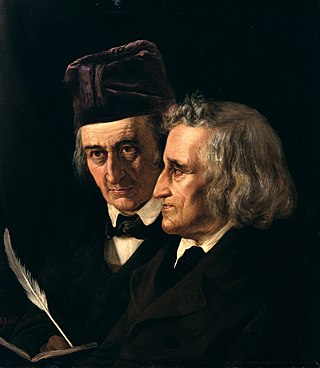
The Brothers Grimm, Jacob (1785–1863) and Wilhelm (1786–1859), were German academics who together collected and published folklore. The brothers are among the best-known storytellers of folktales, popularizing stories such as "Cinderella", "The Frog Prince", "Hansel and Gretel", "Town Musicians of Bremen", "Little Red Riding Hood", "Rapunzel", "Rumpelstiltskin", "Sleeping Beauty", and "Snow White". Their first collection of folktales, Children's and Household Tales, began publication in 1812.

"Rapunzel" is a German fairy tale most notably recorded by the Brothers Grimm and published in 1812 as part of Children's and Household Tales. The Brothers Grimm's story was developed from the French literary fairy tale of Persinette by Charlotte-Rose de Caumont de La Force (1698), which itself is an alternative version of the Italian fairy tale Petrosinella by Giambattista Basile.
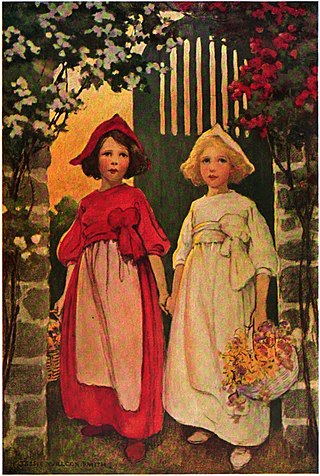
"Snow-White and Rose-Red" is a German fairy tale. The best-known version is the one collected by the Brothers Grimm in 1837 in the third edition of their collection Grimm's Fairy Tales. An older, somewhat shorter version, "The Ungrateful Dwarf", was written by Caroline Stahl (1776–1837). Indeed, that appears to be the oldest variant; no previous oral version is known, although several have been collected since its publication in 1818. Oral versions are very limited regionally. The tale is of Aarne-Thompson type 426.

Dorothea Viehmann was a German storyteller. Her stories were an important source for the fairy tales collected by the Brothers Grimm. Most of Dorothea Viehmann's tales were published in the second volume of Grimms' Fairy Tales.

Grimms' Fairy Tales, originally known as the Children's and Household Tales, is a German collection of fairy tales by the Grimm brothers or "Brothers Grimm", Jacob and Wilhelm, first published on 20 December 1812. Vol. 1 of the first edition contained 86 stories, which were followed by 70 more tales, numbered consecutively, in the 1st edition, Vol. 2, in 1815. By the seventh edition in 1857, the corpus of tales had expanded to 200 tales and 10 "Children's Legends". It is listed by UNESCO in its Memory of the World Registry.
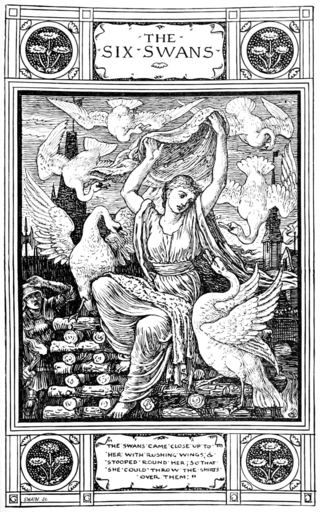
"The Six Swans" is a German fairy tale collected by the Brothers Grimm in Grimm's Fairy Tales in 1812. It is of Aarne–Thompson type 451, commonly found throughout Europe. Other tales of this type include The Seven Ravens, The Twelve Wild Ducks, Udea and her Seven Brothers, The Wild Swans, and The Twelve Brothers. Andrew Lang included a variant of the tale in The Yellow Fairy Book.

"Jorinde and Joringel" is a German fairy tale collected by the Brothers Grimm. It is Aarne–Thompson 405. The tale is found virtually exclusively in Germany, barring a Swedish variant, although Marie Campbell found a variant in Kentucky, "The Flower of Dew". The story is known in many English translations as "Jorinda and Jorindel".
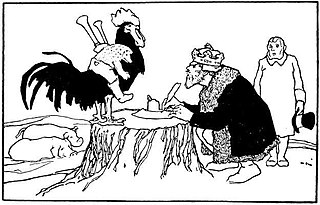
"Hans My Hedgehog" is a German fairy tale collected by the Brothers Grimm. The tale was translated as Jack My Hedgehog by Andrew Lang and published in The Green Fairy Book. It is of Aarne-Thompson type 441.
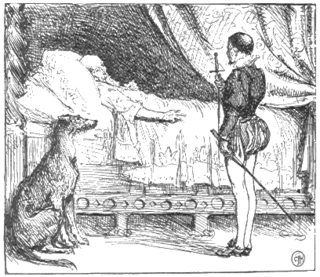
"Trusty John", "Faithful John", "Faithful Johannes", or "John the True" is a German fairy tale collected by the Brothers Grimm and published in Grimm's Fairy Tales in 1819. Andrew Lang included it in The Blue Fairy Book.
How the Devil Married Three Sisters is an Italian fairy tale found in Thomas Frederick Crane's Italian Popular Tales (1885). It was collected and originally published in German as "Der Teufel heirathet drei Schwestern" by Widter and Wolf in 1866.

"Fitcher's Bird" is a German fairy tale collected by the Brothers Grimm, tale number 46.

"The Wolf and the Seven Young Goats" is a fairy tale collected by the Brothers Grimm and published in Grimm's Fairy Tales. It is of Aarne-Thompson type 123 "The Wolf and the Kids".

Ludwig Emil Grimm was a German painter, art professor, etcher and copper engraver.
"The Hazelnut Child" is a Bukovinian fairy tale collected by the Polish-German scholar Heinrich von Wlislocki (1856–1907) in Märchen Und Sagen Der Bukowinaer Und Siebenbûrger Armenier. Andrew Lang included it in The Yellow Fairy Book (1894) and Ruth Manning-Sanders included it in A Book of Dwarfs (1964).

"Cat and Mouse in Partnership" is a German fairy tale collected by the Brothers Grimm in Grimms' Fairy Tales. It is a story of Aarne-Thompson type 15.
The Dragon is an Italian literary fairy tale, included in Giambattista Basile's Pentamerone, first published 1635. In the English language, the tale was a selection in Thomas Keightley's Fairy Mythology (1828), and later appeared in John Edward Taylor 's translation of the entire work, The Pentamerone, or, The Story of Stories, Fun for the Little Ones (1848). The tale has been classed as a version of Aarne–Thompson type 462 "the outcast queens and the ogress queen", rather than as "the dragon-slayer". It exhibits folklore motif K873, "fatal deception by giving narcotic."

The Jew Among Thorns, also known as The Jew in the Brambles, is an antisemitic fairytale collected by the Brothers Grimm. It is a tale of Aarne–Thompson type 592. A similar antisemitic tale in the collection is The Good Bargain.
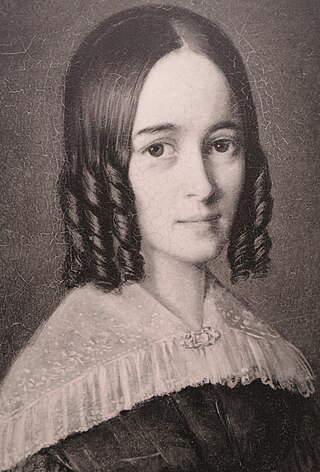
Marie Magdalene Elisabeth Hassenpflug was a German author whose versions of various folk tales were an important source for the collection of tales by the Brothers Grimm. She is best known for her versions of "Little Red Riding Hood" (Rotkäppchen), "Sleeping Beauty" (Dornröschen), and "Snow White" (Sneewittchen).

"The Legend of Knockgrafton" is an Irish folk tale/fairy tale published by T. Crofton Croker in Fairy Legends and Traditions of the South of Ireland (1825).
"Thumbling's Travels" is a German fairy tale collected by the Brothers Grimm in Grimm's Fairy Tales in 1812. The original German name for the character is "Daumerling," not to be confused with the similar tale "Daumesdick" or KHM 37, which was added in 1819. Both tales are frequently translated into English as "Tom Thumb" or "Thumbling" and are categorized as Aarne-Thompson type 700.